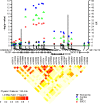A shared susceptibility locus in PLCE1 at 10q23 for gastric adenocarcinoma and esophageal squamous cell carcinoma
- PMID: 20729852
- PMCID: PMC2947317
- DOI: 10.1038/ng.649
A shared susceptibility locus in PLCE1 at 10q23 for gastric adenocarcinoma and esophageal squamous cell carcinoma
Abstract
We conducted a genome-wide association study of gastric cancer and esophageal squamous cell carcinoma (ESCC) in ethnic Chinese subjects in which we genotyped 551,152 SNPs. We report a combined analysis of 2,240 gastric cancer cases, 2,115 ESCC cases and 3,302 controls drawn from five studies. In logistic regression models adjusted for age, sex and study, multiple variants at 10q23 had genome-wide significance for gastric cancer and ESCC independently. A notable signal was rs2274223, a nonsynonymous SNP located in PLCE1, for gastric cancer (P = 8.40 x 10(-9); per-allele odds ratio (OR) = 1.31) and ESCC (P = 3.85 x 10(-9); OR = 1.34). The association with gastric cancer differed by anatomic subsite. For tumors in the cardia the association was stronger (P = 4.19 x 10(-15); OR = 1.57), and for those in the noncardia stomach it was absent (P = 0.44; OR = 1.05). Our findings at 10q23 could provide insight into the high incidence of both cancers in China.
Figures

References
-
- Parkin DM, Bray F, Ferlay J, Pisani P. Global cancer statistics, 2002. CA Cancer J Clin. 2005;55:74–108. - PubMed
-
- Engel LS, et al. Population attributable risks of esophageal and gastric cancers. J Natl Cancer Inst. 2003;95:1404–1413. - PubMed
-
- Tran GD, et al. Prospective study of risk factors for esophageal and gastric cancers in the Linxian general population trial cohort in China. Int. J Cancer. 2004;113:176–181. - PubMed
Publication types
MeSH terms
Substances
Grants and funding
- R37 CA70837/CA/NCI NIH HHS/United States
- R01 CA80205/CA/NCI NIH HHS/United States
- R37 CA070867/CA/NCI NIH HHS/United States
- R35 CA053890/CA/NCI NIH HHS/United States
- R01 CA055069/CA/NCI NIH HHS/United States
- N02-CP-11010/CP/NCI NIH HHS/United States
- N02-SC-66211/SC/NCI NIH HHS/United States
- HHSN261200477001C/CA/NCI NIH HHS/United States
- R01 CA082729/CA/NCI NIH HHS/United States
- ZIA CP000112/ImNIH/Intramural NIH HHS/United States
- N01-SC-91030/SC/NCI NIH HHS/United States
- R01 CA144034/CA/NCI NIH HHS/United States
- N02 CP011010/CP/NCI NIH HHS/United States
- R01 CA82729/CA/NCI NIH HHS/United States
- R01 CA080205/CA/NCI NIH HHS/United States
- ZIA CP000185/ImNIH/Intramural NIH HHS/United States
- Z99 CA999999/ImNIH/Intramural NIH HHS/United States
LinkOut - more resources
Full Text Sources
Other Literature Sources
Medical
Molecular Biology Databases

